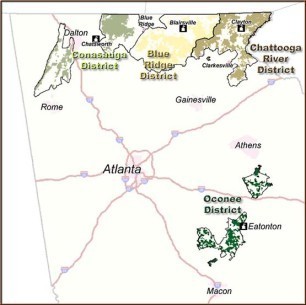COLUMBIA, S.C. - Growing populations and increased urbanization could reduce the 200 million acres of forestland in the South, including Georgia's Chattahoochee-Oconee National Forests - by about 10 percent over the next 50 years, according to a U.S. Forest Service study released Tuesday.
The multiyear study looks at the impact a variety of factors will have on the future of forests in 13 states stretching from Texas to Virginia.
``The diversity in Southern forests is unparalleled in North America,'' said Dave Wear, the project leader on the report. But that diversity and the home it provides to a variety of wildlife is threatened by a combination of four primary factors: population, climate change, timber markets and invasive species.
But population growth and the ensuing urbanization are expected to reduce the amount of forestland in the South by as much as 23 million acres about the size of the state of South Carolina and stress other resources that forests depend on for survival.
``The growing population reduces the capability of forestry agencies to manage forests,'' Wear said. About 90 percent of the region's forestland is owned by companies and individuals, and the rest is owned and managed by U.S. or local government agencies.
One example of how encroachment of development can damage forests is the use of controlled burns to rejuvenate forests. Land managers are less likely to use that method if homes are too close to the forest. That could create a layer of undergrowth that would promote uncontrollable wildfires that could threaten forests and homes.
Shrinking forests also could affect other resources people depend on, like clean water. The report says an increase in demand brought on by population growth and stress on water supplies caused by climate change and land-use changes could result in more frequent water shortages and lower water quality.
``The full range of forecasts raises concerns about water in the South and strengthens the link between forests and the future availability and quality of water,'' the summary report says.
Another threat is foreign species of plants and insects. Nonnative plants have infested almost 10 percent of the region's forests and can spread rapidly, replacing native plants needed by local wildlife.
The report does not make suggestions for land use or management. Rather, its authors see it as a tool for land managers and others to use as they consider policy changes.
``We're counting on policy-makers ... to implement and act on some of the findings,'' said John Greis, a resource analyst with the U.S. Forest Service and co-author of the report. ``That is our hope.''
A later phase of the report will look at issues specific to smaller areas and how different land-management actions would affect the forecasts.
Thursday
June 26th, 2025
3:24PM

















